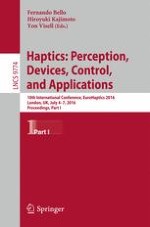2016 | OriginalPaper | Chapter
Going Against the Grain – Texture Orientation Affects Direction of Exploratory Movement
Authors : Alexandra Lezkan, Knut Drewing
Published in: Haptics: Perception, Devices, Control, and Applications
Publisher: Springer International Publishing
Activate our intelligent search to find suitable subject content or patents.
Select sections of text to find matching patents with Artificial Intelligence. powered by
Select sections of text to find additional relevant content using AI-assisted search. powered by
